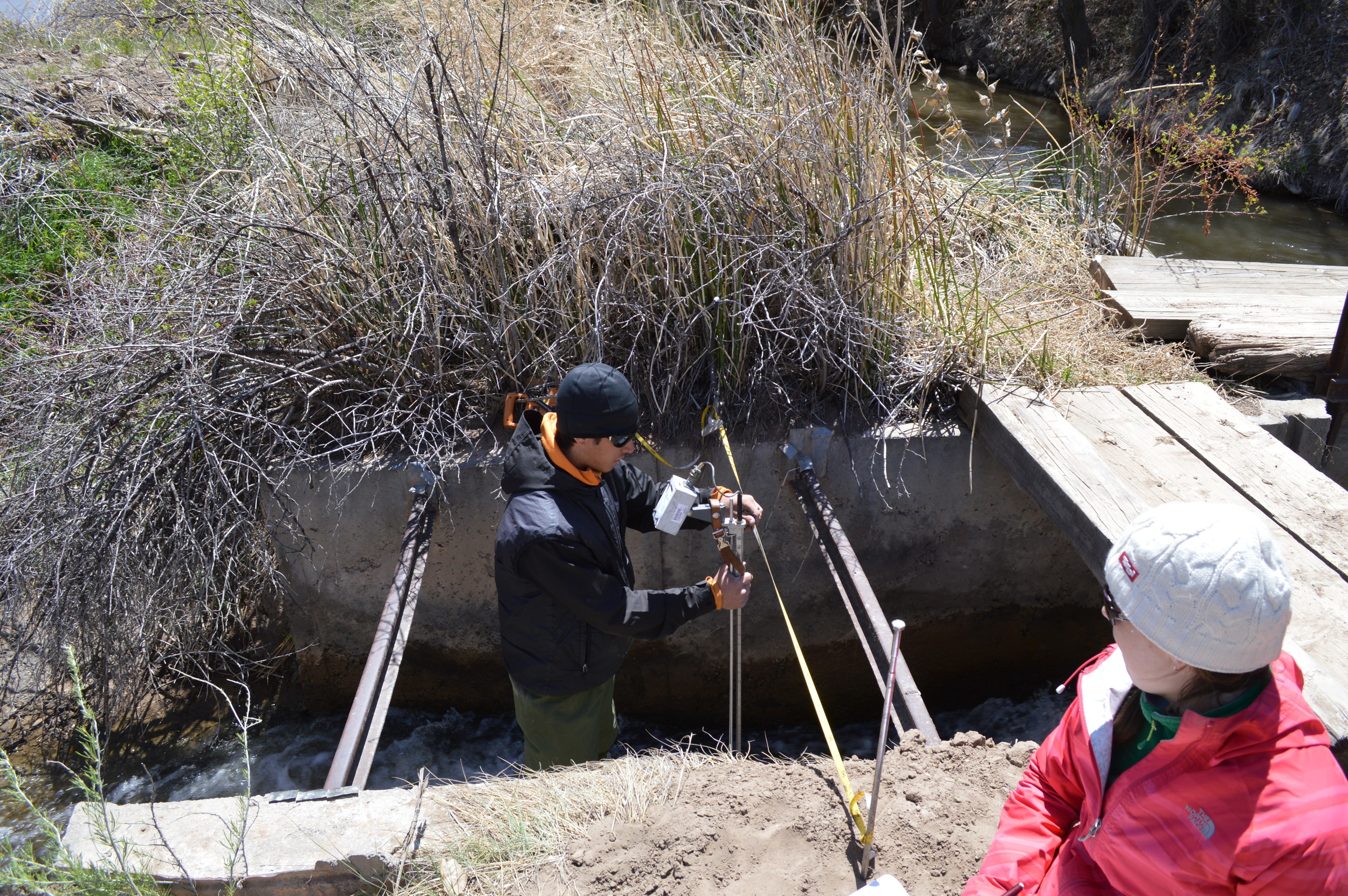Aaron Kimple (MSI) samples on the Lower Animas River near Aztec, NM.
The Lower Animas Watershed Based Plan is a study designed to address nutrient impairment and associated total maximum daily load on the lower stretch of the Animas River for the purpose of providing stakeholders and managers with a comprehensive plan to efficiently address the concerns. This study aims to compile data that relates water quality to land use and pollutant sources that will eventually lead to the identification of best management practices that will address the sources and allow for the creation of a strategic plan that managers can use to reduce pollutant loading in the lower Animas River.
Isaac Cadiente (Terra Environmental LLC) measures ditch flow near the Colorado border along the Animas River
Although there have been numerous studies done on this reach of the Animas River and surrounding areas, there is no comprehensive plan that utilizes this data and presents it in a manner that can be used by stakeholders and managers to efficiently address the concerns. The goal of creating an updated plan for the Lower Animas is to compile information and present it in a way that relates water quality data to land use and pollutant sources, identify the best management practices that will best address these sources, and create a strategic plan that managers can use to move forward with implementation.
San Juan Watershed Group (SJWG) and Animas Watershed Partnership (AWP) have undertaken multiple planning efforts which included this stretch of river. The San Juan Basin Watershed Management Plan (SJBWMP; http://www.nmenv.state.nm.us/swqb/Projects/SanJuan/BasinPlan/ SanJuanBasinPlan.pdf) was completed in 2005 as a “Watershed Restoration Action Strategy” (WRAS) and while it gives a qualitative overview of water quality issues within four 8-digit HUCs (Animas River Watershed HUC 14080104, Upper San Juan Watershed HUC 14080101, Blanco Canyon HUC 14080103, and the Middle San Juan Watershed HUC 14080105), it does not include the detail or quantitative loading information necessary to satisfy EPA’s 9 key elements.
The Animas River is very important chick hatching grounds for migrating Canadian Geese.
The SJWG has been awarded three grants from the New Mexico Environment Department since the completion of the 2005 SJBWMP (Phases I-III of the Collaborative Water Quality Improvement Project for the San Juan Watershed; https://sites.google.com/site/sanjuanwatershedgroup/projects/reports), which funded studies and implementation of associated BMPs. The Animas Nutrient Study, the Irrigation Ditch Nutrient and Bacteria Study, and a portion of the Stormwater Nutrient and Bacteria Study were conducted on the Animas River to identify activities and land use practices that were contributing sources of plant nutrients. The results indicate that a variety of non-point source activities have a cumulative impact in increasing nutrient levels from the Colorado border to the confluence with the San Juan River.
Nutrient enrichment is not only a function of nutrient loading, but also a function of diminished assimilative capacity. Channel modification and other disturbances to the floodplain can adversely affect assimilative capacity. Examples of channel modification and floodplain disturbance include:
Improper rip-rap and poorly engineered bank stabilization projects
Loss of wetlands and native riparian habitat
Bank hardening and cut banks
Stormwater studies done on the San Juan and the La Plata Rivers identified land use practices as possible contributing sources of E. coli bacteria, but this has not yet been investigated on the Animas River. Probable sources of fecal coliform and E. coli bacteria include:
Livestock grazing and flood irrigation of grazed pasture
Livestock grazing and holding along perennial streams
Stormwater runoff from pasture and rangeland
Stormwater runoff from large ephemeral washes (e.g. Canyon Largo)
Septic systems
The crucial data gap in all of the above studies conducted by the SJWG is that they do not identify the extent to which the above land uses are present throughout the landscape, or ways to prioritize implementation projects in order to have the maximum reduction in pollutant loading.
Aaron Kimple measuring flow of an arroyo that inputs to the Animas River near Farmington, NM.
SJWG’s recent activities have focused on further identifying the sources of nutrients impairment and E. coli bacteria in the San Juan River and Animas River. The SJWG is in the process of conducting a Microbial Source Tracking (MST) Study, to be completed in 2014, that is designed to identify the source of E. coli bacteria in the river as human, cattle, horse, dog, or waterfowl. The MST and LAWBP studies will allow for implementation of targeted Best Management Practices (BMPs) that address specific sources of bacteria and nutrients in the rivers. The Lower Animas WBP will augment previous studies and the current MST study to provide the detailed, local scale information necessary to address water quality issues along the lower Animas River.









